
How Airbyte built a warm outbound motion to 2x its year-over-year pipeline growth rate
“We generated more pipeline in the first six months of the year than in the entire last year and I'm going to say a lot of that is attributable to our reps using Common Room.”

Mario Moscatiello
Head of Growth
Business model
- Open-source
- Product-led
- Enterprise
Teams
- Ops
- BDRs
- AEs
- Marketing
Use cases
- Unified customer view
- Lead and account scoring
- Account-based sales
- GTM workbench
- Workflow automation
- AI agents
Key signals
Summary
How Airbyte turns buyer intelligence into pipeline with AIAbout Airbyte
Airbyte is an open-source data integration platform and ELT tool used by teams at Disney, Deloitte, Zillow, Monday.com, and many more.
Problem
Airbyte needed a scalable system for signal capture, enrichment, and engagement to build its outbound motion and meet aggressive growth goals.
Solution
Airbyte used Common Room to create a repeatable warm outbound methodology and provide sales reps with actionable intent signals, prospect identities, prioritized lead lists, AI research, and helpful outreach automations—all in one place.
Strategy
Airbyte uses Common Room to scale proven outbound plays across sales and empower reps to reach out to in-market buyers at high-fit accounts fast and with full context. Airbyte also uses Common Room to help marketing execute more precise ABM campaigns.
Results
Common Room generated:
- 2x year-over-year pipeline growth rate
- 10% more pipeline over the previous year in six months
Key quotes

“Signal trends are super helpful for prioritizing prospects and increasing speed to lead in an informed way. I want my teams to know if there’s a surge in signals we care about—and I want that intel baked into our scoring. Common Room makes it easy because it’s a true system of record, not a static spreadsheet. Signal aggregation, volume, trends—it’s all automated and ready to action out of the box.”

Mario Moscatiello
Head of Growth

“RoomieAI Spark notifications are really helpful to give context so that the BDRs or the AEs or the reps in general can take action that is informed because they have so much to do that we just need to feed them. They don't have to think, they just have to be fed and just take action.”

Mario Moscatiello
Head of Growth

“We’re turning Common Room into our go-to-market command center. We’re pulling in signals like product usage, job changes, news events, and more, identifying high-fit contacts, and automating action on them. With Common Room, every rep can be a top performer.”

Jean Lafleur
Cofounder and COO
Every go-to-market org is different—different signals, different audiences, different rules of engagement.
That’s why organizations like Airbyte invest in tooling that not only serves up actionable intelligence to sales and marketing, but molds itself to their unique ways of working.
Here’s how Airbyte used Common Room to:
- Customize a repeatable warm outbound motion
- Serve ready-to-action leads to GTM teams on autopilot
- Exceed annual pipeline targets in only six months
Unlock actionable intelligence
Mario Moscatiello was one of Airbyte’s first few angel investors before he became the company’s Head of Growth.
He took the reins of Airbyte’s go-to-market strategy shortly after the company began monetizing its open-source data integration software, with marketing, DevRel, RevOps, and the BDR team all reporting to him.
His first order of business? Building a brand new outbound motion.
That meant hiring new headcount—and equipping them with the data and tools they need to identify, prioritize, and engage warm prospects.
“We have a lot of signals—product, web traffic, social,” Mario said. “I wanted to layer on a warm outbound motion to complement the hand raisers who want to talk to sales and, in parallel, inform our ABM strategy.”
Mario had built out systems for signal-based GTM in previous roles, self-engineering plays using a combination of product sign-up data, reverse IP lookups, Clearbit-based ICP validation, and various APIs.
But the DIY approach came with downsides.
“Doing it yourself requires a full-stack engineer,” Mario said. “And all of that was something that we had to maintain because it was breaking every day. It wasn’t really a scalable strategy.”
The team had already purchased Common Room when Mario came aboard. He immediately saw it as a way to design his ideal GTM motion.
Common Room auto-captures all the signals Airbyte cares about—across GitHub, website visits, Discourse, X (Twitter), Stack Overflow, LinkedIn, Slack, Reddit, and more—and combines them with signals surfaced from the company’s owned data sources, including product usage, CRM records, and call transcripts, all in one place.
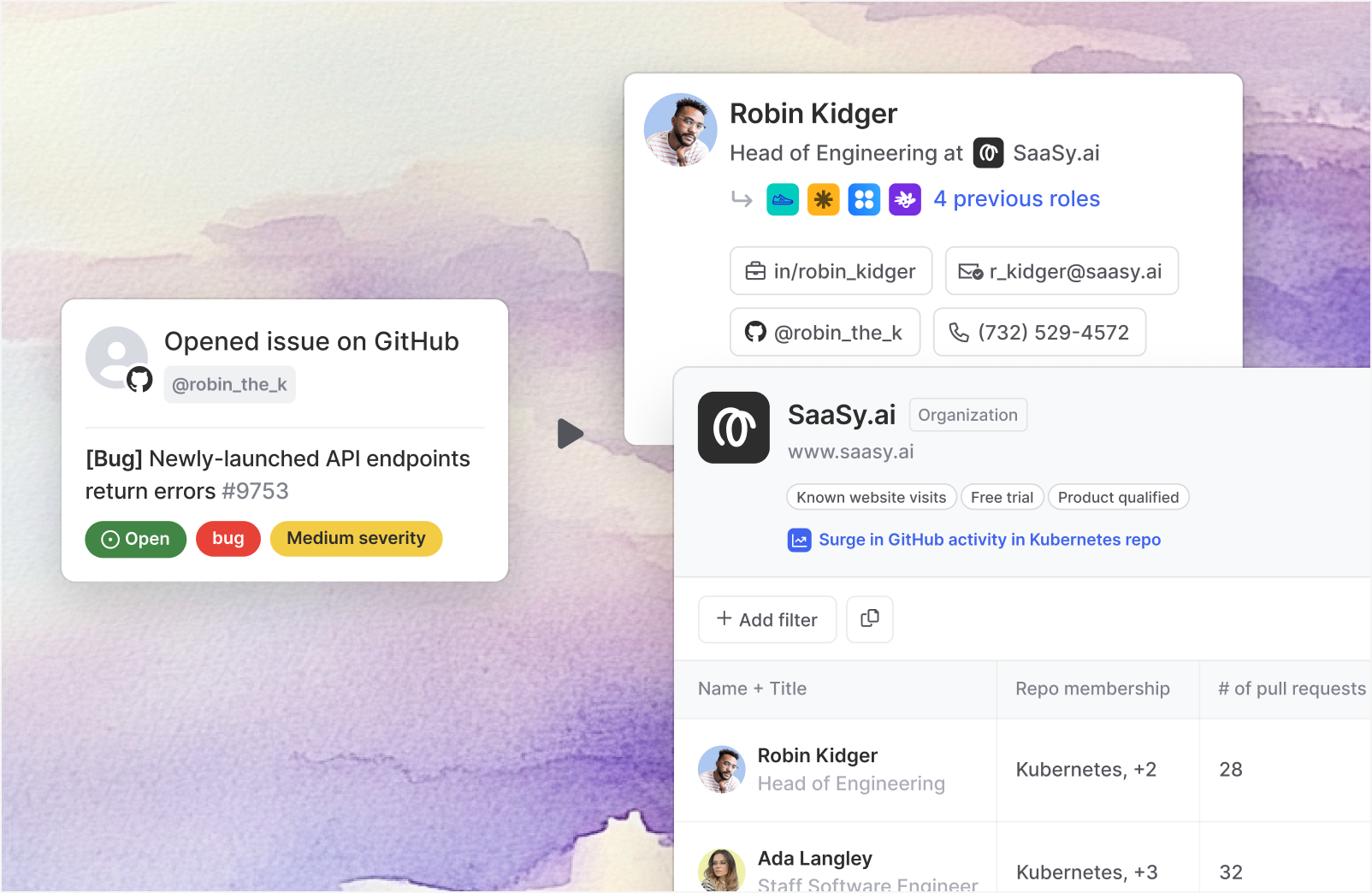
Common Room’s AI-powered signal capture automatically fetches contact, account, and activity data from your first-, second-, and third-party data sources. Our machine learning algorithms process this data and turn it into structured outputs for team members to access, analyze, and action on.
But spotting hard-to-see signals is only half the battle. Mario also wanted to cut through the noise to focus on the 20% of accounts that will drive 80% of results.
That required full visibility into activity at both the person and account level.
Common Room’s identity and enrichment engine—Person360™—automatically transforms signals into a unified profile of every person and company active in Airbyte’s digital ecosystem.
Out-of-the-box AI waterfall enrichment creates a comprehensive, always up-to-date view of each person and their organization across channels versus a static contact record in Salesforce.
This includes names, job titles, work histories, email addresses, phone numbers, recent behavioral data, and firmographic details.
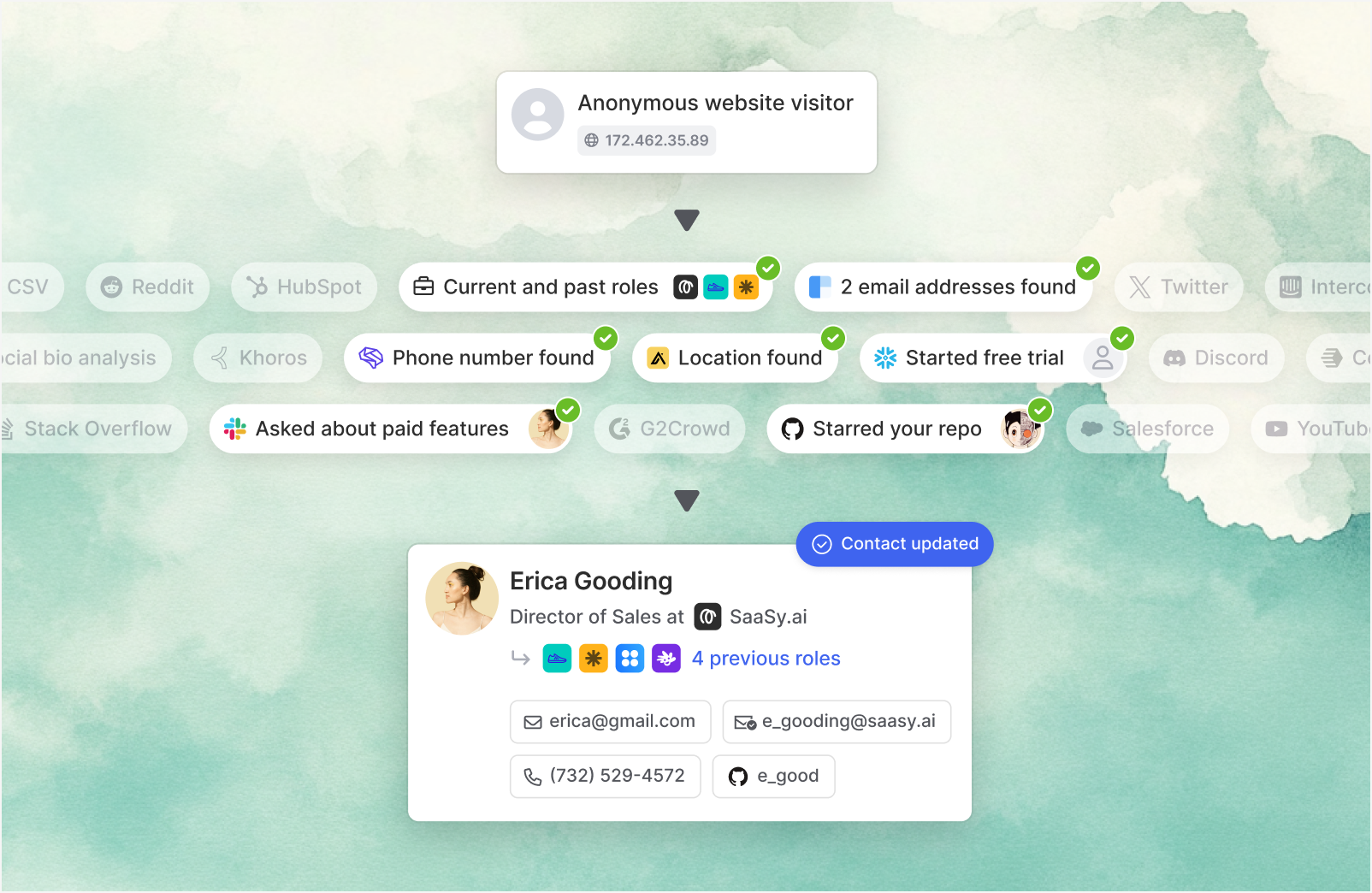
Common Room’s out-of-the-box identity and enrichment engine uses machine learning models to automatically deanonymize contact and account activity, merge cross-channel signals into unified profiles, and fill in the blanks with rich contextual data.
The ability to slice and dice this data—and mold it to his GTM vision—was a major differentiator for Mario.
“That’s one of the things that separates Common Room from other tools—it’s highly customizable,” Mario said. “For example, I can go and build 10 different lead scores. I can go and stack those scores. I can go and literally tell you, ‘This is the one thing that is important to me, assign more points to this specific action within the things.’”
Auto-surface high-fit, high intent leads
Mario and his team have built out numerous segments for contacts and organizations showing different buying signals, from GitHub activity to product usage to web visits.
Each segment acts as a bespoke burndown list for individual reps, automatically adding prospects and companies for them to outbound when Airbyte’s custom criteria for fit and behavior are met—and automatically updating the list to match reps’ books of business.
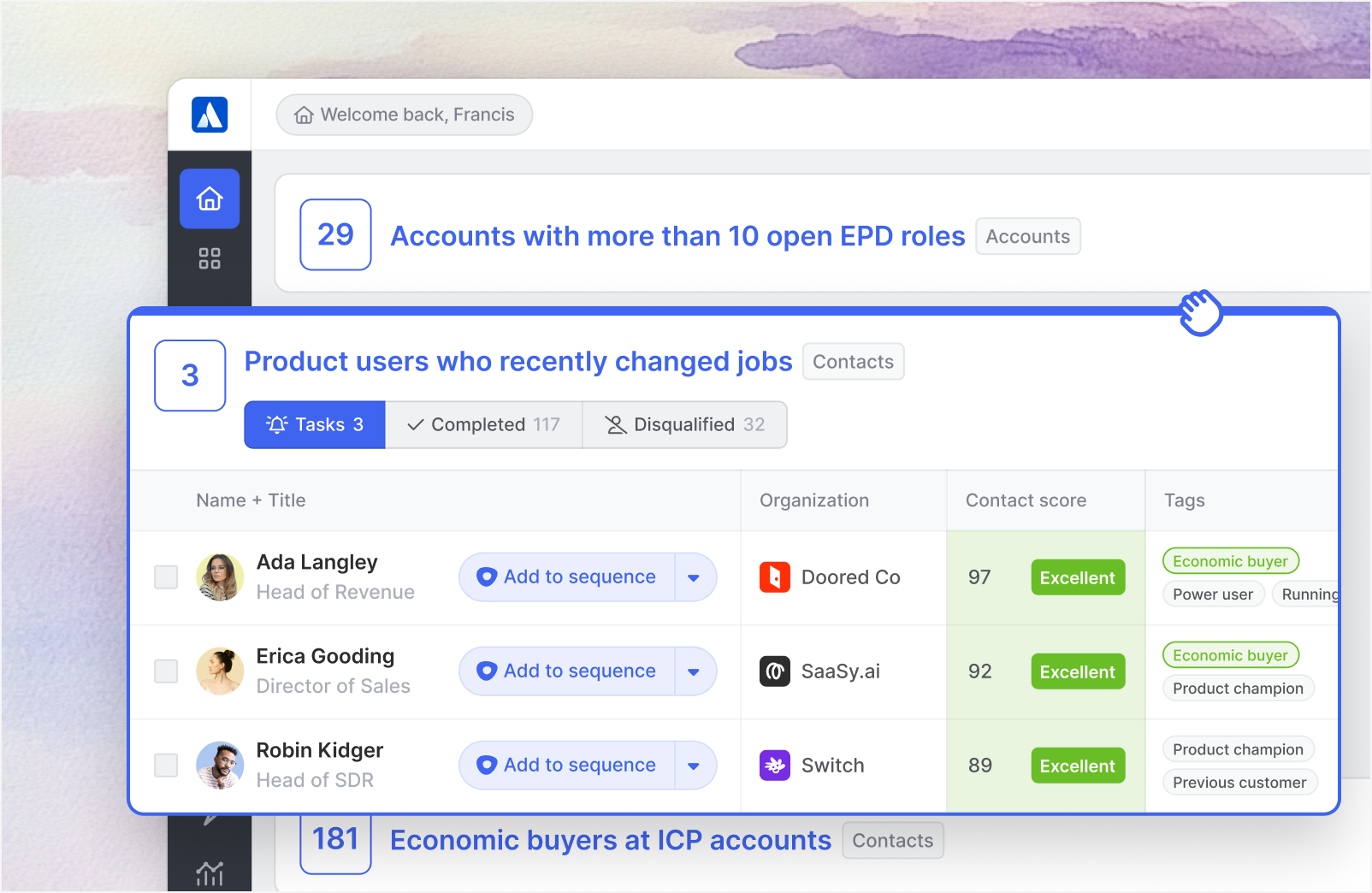
Common Room’s intelligent automations build auto-replenishing segments using your custom filtering criteria, automating play creation based on any combination of contact, account, and activity signals.
The team has 10-15 segments running at any given time, including evergreen segments that tell reps whenever someone at an account that matches their ideal customer profile takes an action they want to know about.
“We have plays that we run every day—our speed-to-lead plays—like website visits,” Mario said. “And then we have plays that are more about ICP criteria.”
Examples include:
Product-led and open-source plays
When you sell open-source developer tools, most intent signals come from below-the-line engineers. But at the end of the day, purchase decision-makers tend to be VP-level-and-above stakeholders.
Mario wanted to be able to rapidly answer two questions when his team spotted signals across digital channels:
- Does the person’s organization match Airbyte’s ICP?
- If so, who are the economic buyers at the account?
Instead of reaching out to the engineer who starred a GitHub repo or submitted a pull request, Mario wanted his GTM org to use those signals to triangulate intent and zero in on the people with budget authority.
“When the BDRs pick up the phone and call the VP, the VP will go to the engineers and say, ‘Hey, I got pinged by this company Airbyte,’” Mario said. “If we’re doing our job right, the engineers will be like, ‘Of course, we love Airbyte!’ And that's really when the magic happens.”
Signal stacking and event-based plays
In addition to digital signals, the team at AIrbyte also incorporates signals from in-person events.
“We like to stack signals,” Mario said. “A super powerful thing for us is when we go to events, we don't just give a list of target accounts to BDRs, we upload it to Common Room and we look at what accounts have already shown intent. We treat a booth scan as another signal to layer on and prioritize the list, and that increases our conversion.”
With Common Room’s signal trends feature, Mario can also spotlight accounts showing a high volume of signals or that are seeing a rapid uptick in intent activity.
“Signal trends are super helpful for prioritizing prospects and increasing speed to lead in an informed way,” Mario said. “I want my teams to know if there’s a surge in signals we care about—and I want that intel baked into our scoring. Common Room makes it easy because it’s a true system of record, not a static spreadsheet. Signal aggregation, volume, trends—it’s all automated and ready to action out of the box.”
Timing-based plays
Former product users who recently changed jobs and landed at ICP-match companies are obvious outbound opportunities.
So are ICP orgs that are seeing a surge in hiring for roles that would benefit from Airbyte’s product.
And so are contacts at closed-lost accounts that previously showed interest but didn’t close due to timing or budget reasons.
Mario and his team have set up segments for all of the above in Common Room, automatically serving up low-hanging fruit to reps on a regular basis.
Go from signal to send with full context
When a rep clicks into a contact segment, they can immediately see when the person was last on the website, their org’s size, industry, and location, and other key information pulled in from SFDC and HubSpot.
Meanwhile, when reps view organizations in Common Room, they’re served up details about capital raised, annual revenue, and product practitioner count.
Either view provides them with multiple scores reps use to prioritize prospects and accounts: intent, account fit, MQLs, PQLs, and so on.
And unlike legacy ABM tools, Common Room shows reps exactly why contacts and companies are scored the way they are in plain English.
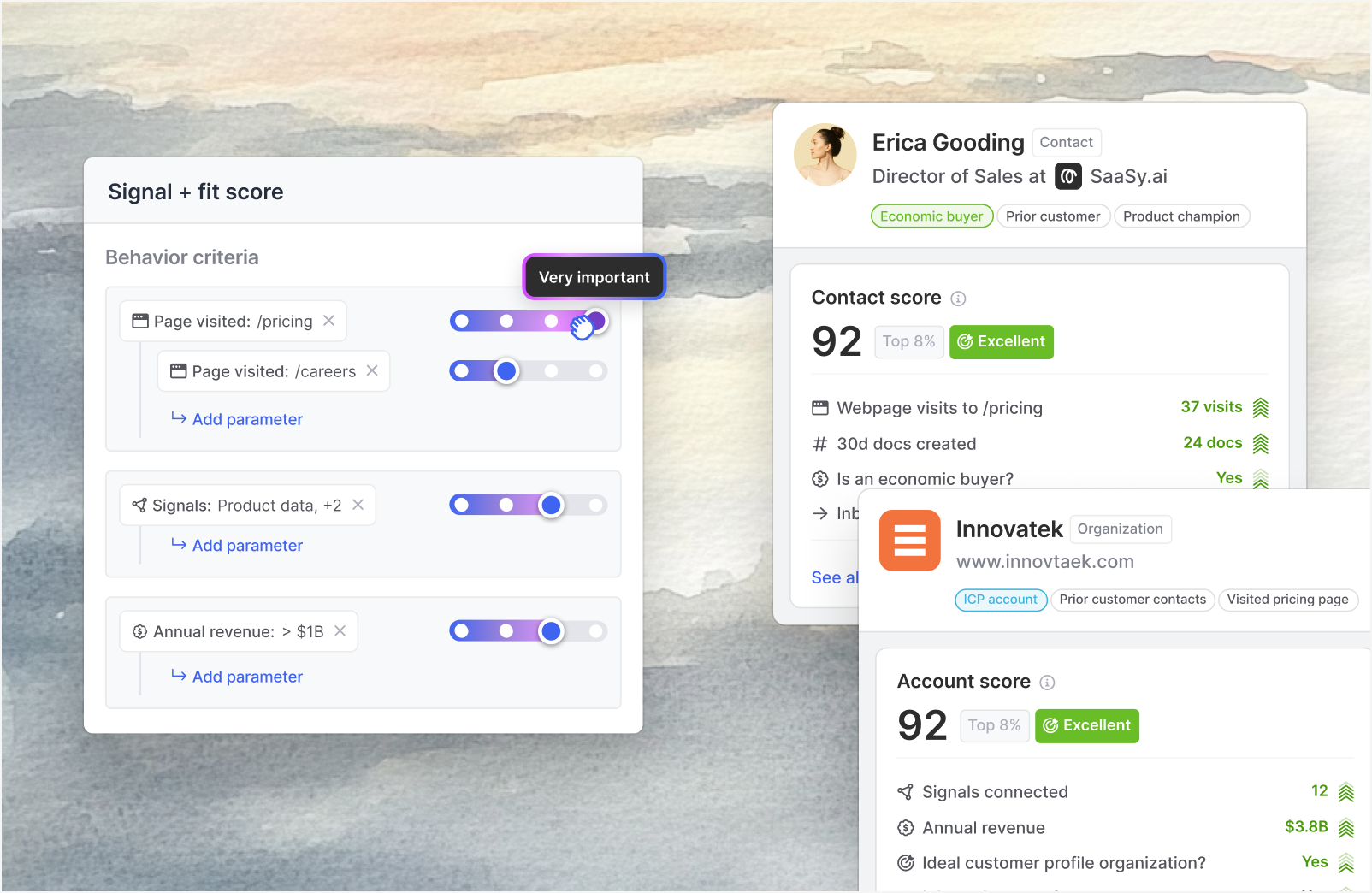
Common Room’s signal-based scoring creates contextual lead and account scores based on machine learning-enriched fit and behavioral data. Scores—and the context behind them—are refreshed daily using your custom rules, parameters, and weighting.
If reps are evaluating an account but only have developer activity to work off of, they can use Common Room’s Prospector feature to automatically find and enrich decision-makers based on their custom filtering criteria.
AI-powered prospectingCommon Room’s Prospector retrieves prospects and companies from a proprietary, constantly refreshed database of more than 200 million B2B contacts and accounts based on your custom filtering criteria. These people and organizations are then enriched via machine learning-powered models.
Reps can also use offsite keyword search to identify in-market accounts via Common Room’s Bombora signal data, which pulls account-level search intent from thousands of sources and billions of monthly consumption events.
“Common Room’s partnership with Bombora offers the best of both worlds: offsite intent at the account level and intent signals bubbling up across channels at the contact level,” Mario said. “It opens the door to something missing from legacy ABM tools: The ability to quickly target in-market accounts and reach out to the right buyer just as fast.”
Once reps are ready to action, they can send or sequence from any segment with the press of a button.
Accelerate speed to lead with AI and automation
Airbyte doesn’t just auto-surface hot leads in Common Room—it also brings them directly to reps via a person-level research agent.
RoomieAI Spark alerts reps to leads in real time in Slack, showing them which ones they should prioritize, why they matter right now, and what to say next via contextual AI summaries that pull from all the person- and account-level data captured in Common Room.
Reps can action on RoomieAI Spark alerts from Slack, adding hot prospects to Outreach sequences with a click.
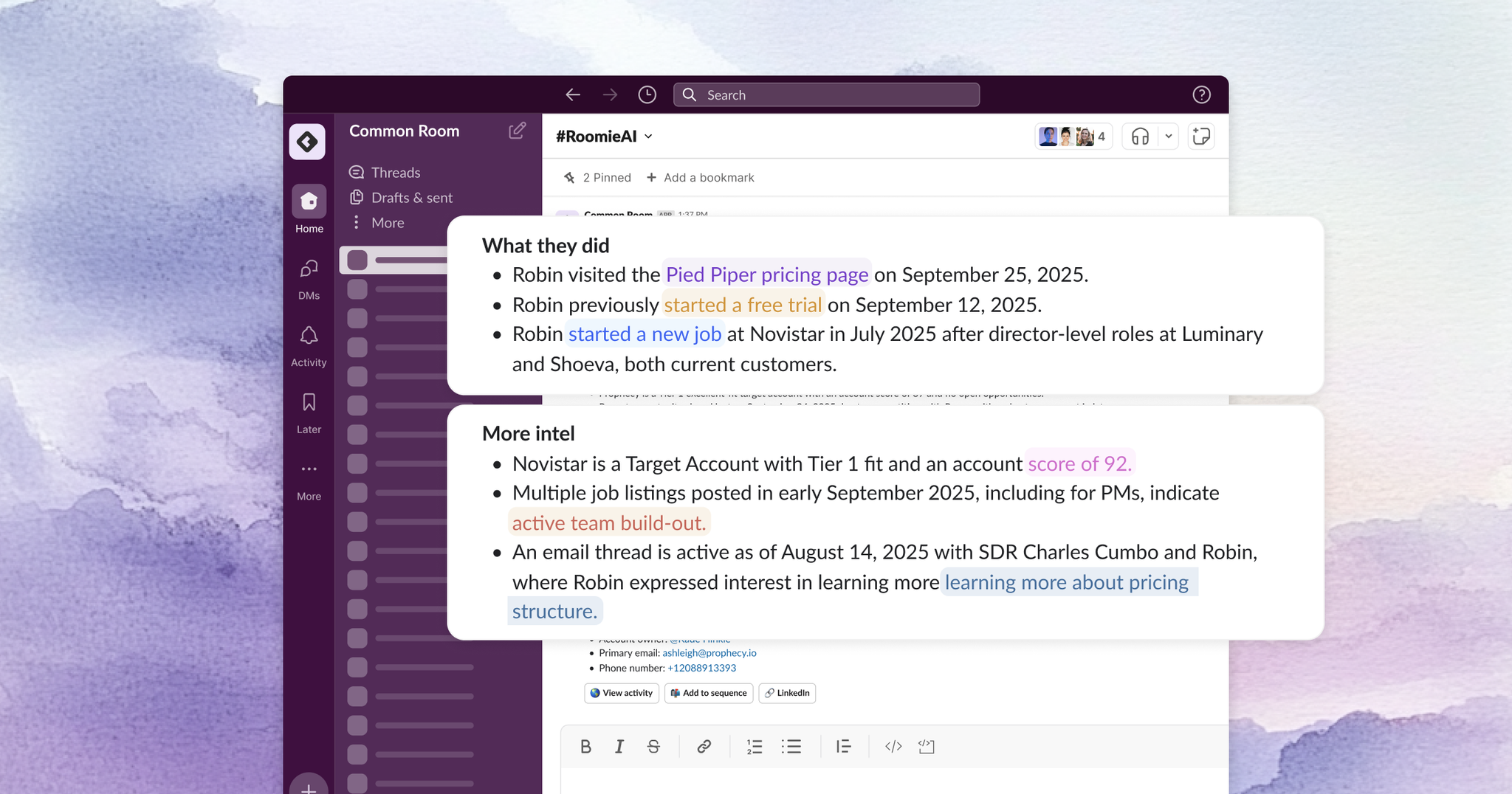
RoomieAI Spark automatically delivers contextual, person-level insights to reps, both in Common Room and as real-time Slack alerts. These AI summaries make it easy to rapidly prioritize and tailor prospect outreach, as well as ensure no hot leads slip through the cracks.
“RoomieAI Spark notifications are really helpful to give context so that the BDRs or the AEs or the reps in general can take action that is informed because they have so much to do that we just need to feed them,” Mario said. “They don't have to think, they just have to be fed and just take action.”
Another automated workflow Airbyte uses is turning data from Clay into SFDC fields that are automatically pumped into Common Room and made filterable for reps.
For example, Airbyte pushes account lists from Common Room to Clay and runs a specialized enrichment to see if the companies operate in a regulated industry. Clay returns a yes or no answer. These answers then become a field that reps can apply to account lists in Common Room, where they can take action.
“Clay is not a system of record, it's a spreadsheet,” Mario said. “You can’t have reps working in a spreadsheet. Common Room is like a full-on CRM.”
When reps are ready to action, they can add contacts to prebuilt Outreach sequences directly from Common Room (or from SFDC, HubSpot, or LinkedIn using Common Room’s Chrome Extension).
Mario’s goal is to automate as much of this process as possible while enabling reps to tailor messaging on the fly with Common Room’s AI writing assistant.
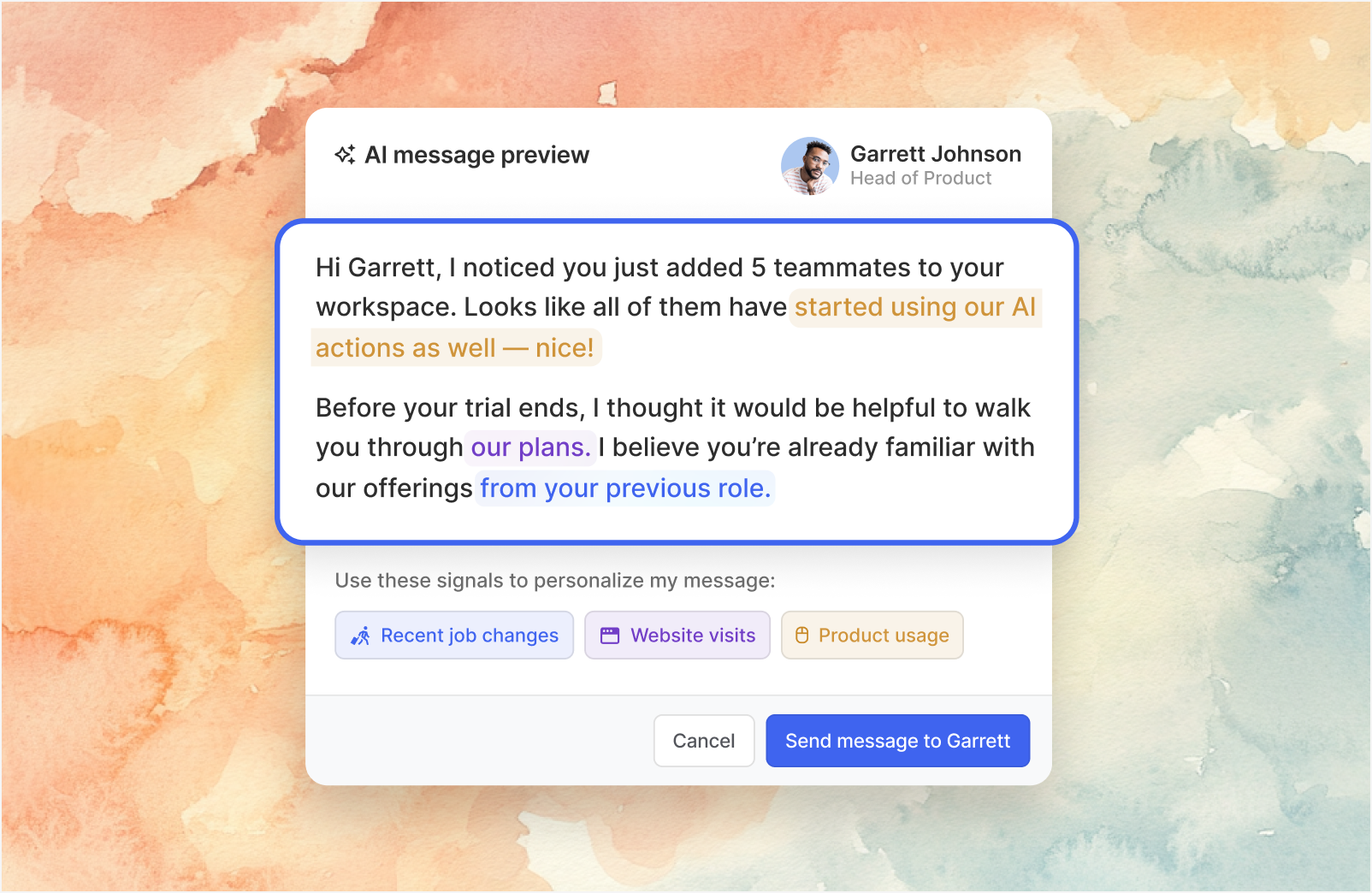
RoomieAI Activate crafts highly personalized, highly relevant messaging for every contact in real time using retrieval augmented generation. Send or sequence messaging with a single click or automate outreach from end to end.
Empower every part of GTM
Sales reps aren’t the only ones active in Common Room.
For instance, the marketing team at Airbyte pushes audiences from Common Room to SFDC, which are then pushed to Vector for ABM retargeting.
Common Room not only helps the marketing team with its account-based strategy, but also general brand marketing.
Person-level signal capture allows the team to see the effects of its various campaigns in real time, no form fill necessary.
“It's easier than ever to justify brand investment now,” Mario said. “It was so hard to justify brand investment. Now I plug into Common Room and I'm like, ‘Yeah, we ran a brand campaign and look at what the uplift on the ICP on our website has been in the last 30 days.’”
Common Room’s flexibility and ease of use have opened up the doors to much more GTM experimentation across teams.
“I think the way I would put it to people is that if someone were to join Airbyte as an intern in the summer, I would expect them to be able to ship signal-based play experiments on their own now because it's so easy to do,” Mario said.
Results
Since Mario rolled out his new GTM strategy with Common Room, Airbyte exceeded its annual pipeline numbers in half the time—a 10% year-over-year increase in only six months.
“We generated more pipeline in the first six months of the year than in the entire last year and I'm going to say a lot of that is attributable to our reps using Common Room,” Mario said.
As Airbyte cofounder and COO Jean Lafleur put it:
“We’re turning Common Room into our go-to-market command center. We’re pulling in signals like product usage, job changes, news events, and more, identifying high-fit contacts, and automating action on them. With Common Room, every rep can be a top performer.”
Airbyte is the open standard for data movement. It’s made Common Room its standard for pipeline generation.
Mold customer intelligence to your pipegen motion with Common Room
Get in touch to see how Common Room can help you deliver actionable pipeline intel to GTM teams where they work and how they work.
We think you'd like these
How incident.io upgraded from legacy prospecting tools to boost pipegen performance
2x faster pipegen
See how incident.io used Common Room to generate more meetings booked in much less time.Read full storyHow Homebot used AI agents to generate $1.5M in new pipeline in a single month
250% ROI
See how Homebot used Common Room to generate $1.5 million in new pipeline in one month.Read full storyHow Grammarly put the power of AI into the hands of reps to 2.5x meetings booked
2.5x more meetings booked
See how Grammarly used Common Room to 2.5x meetings booked and 2.4x closed-won pipeline.Read full story
